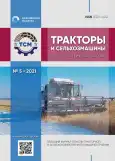Evaluation of the offset of the angular scale to improve the control accuracy of the single-cylinder engine
- Authors: Abramov P.V.1
-
Affiliations:
- LLC Scientific Production Enterprise ITELMA
- Issue: Vol 88, No 5 (2021)
- Pages: 55-64
- Section: Quality, reliability
- URL: https://journals.rcsi.science/0321-4443/article/view/105671
- DOI: https://doi.org/10.31992/0321-4443-2021-5-55-64
- ID: 105671
Cite item
Full Text
Abstract
A significant reduction in the cost of controlling a single-cylinder engine with positive ignition for small-scale mechanization can be achieved by replacing material sensors with virtual ones. The information required for control can be extracted from the crankshaft speed. The reliability of the mixture composition estimate based on the intracycle variation of the crankshaft angular velocity depends on many factors, including the installation accuracy of the position sensor of the given shaft and the synchronization disk or other element for determining the angular position of the crankshaft in the selected reference system.
The properties of a single-cylinder engine are revealed. These make it possible to significantly weaken the effect of the displacement of the angular scale on the accuracy of assessing the composition of the mixture by the kinematic parameters of the engine operation, as well as to evaluate the displacement itself.
The experiments were carried out on a general-purpose engine Honda iGX440 with a displacement of 0,44 liters, equipped with an experimental electronic control system for fuel injection, ignition and throttling. The hydraulic brake was used as the load.
The displacement of the angular scale can be determined in various ways: by the deviation of the phase of the harmonic of the kinetic energy of the crank mechanism of any observed order at the extremum of the dependence of this phase on the ignition timing, all other things being equal; by the shift of the derivative with respect to the ignition timing of the specified dependency; by the shift of the dependence of the difference of this phase and the ignition timing from the latter; by the deviation of the phase of the harmonics of the kinetic energy of the crank mechanism of higher orders at the ignition timing, leveling the effect of the displacement of the scale on the phase of the fundamental harmonic of the kinetic energy of the crank mechanism.
Refinement of the position of the crankshaft by evaluating the displacement of the scale by the proposed methods will preserve the necessary accuracy of control of the ignition advance angle on single-cylinder engines while increasing the tolerance for the installation of elements for determining the angular position of the crankshaft.
Full Text
##article.viewOnOriginalSite##About the authors
P. V. Abramov
LLC Scientific Production Enterprise ITELMA
Author for correspondence.
Email: abhpv@yandex.ru
PhD in Engineering
Russian Federation, VladimirReferences
- Ravenhill P., et al. Low cost electronic fuel injection for motorcycles and utility engines // SAE Paper 2009-32-0149.
- Service manual. EX13, 17, 21, 27, SP170, SP210, EX21 electronic fuel injection engines. Robin America, Inc., 2009. URL: https://www.subarupower.com/media/manuals/129036362809063750.pdf (accessed: 14.08.2021).
- Takano Y., et al. Development of intake air pressure sensorless fuel injection system for small motorcycles // SAE Paper 2011-32-0564.
- Nishida K., et al. Estimation of indicated mean effective pressure using crankshaft angular velocity variation // SAE Paper 2011-32-0510.
- Seuling S., et al. Model based engine speed evaluation for single-cylinder engine control // SAE Paper 2012-32-0044.
- Abramov P.V., Svirin O.A., Sukhov S.P., Kochetkov A.A. Estimation of the filling and composition of the mixture in a single-cylinder engine with forced ignition from the intracycle variation of the angular velocity of the crankshaft. Fundamental’n·yye problemy sovershenstvovaniya porshnevykh dvigateley: Materialy XII Mezhdunar. nauch.-prakt. konf. [Fundamental problems of improving piston engines: Proceedings of the XII International scientific-practical conference]. Vladim. gos. un-t. Vladimir, 2010, pp. 79−86 (in Russ.).
- Abramov P.V. Phase regulator of the mixture ratio for a single-cylinder engine. Dvigatelestroyeniye. 2021. No 2, pp. 26−30 (in Russ.).
Supplementary files













